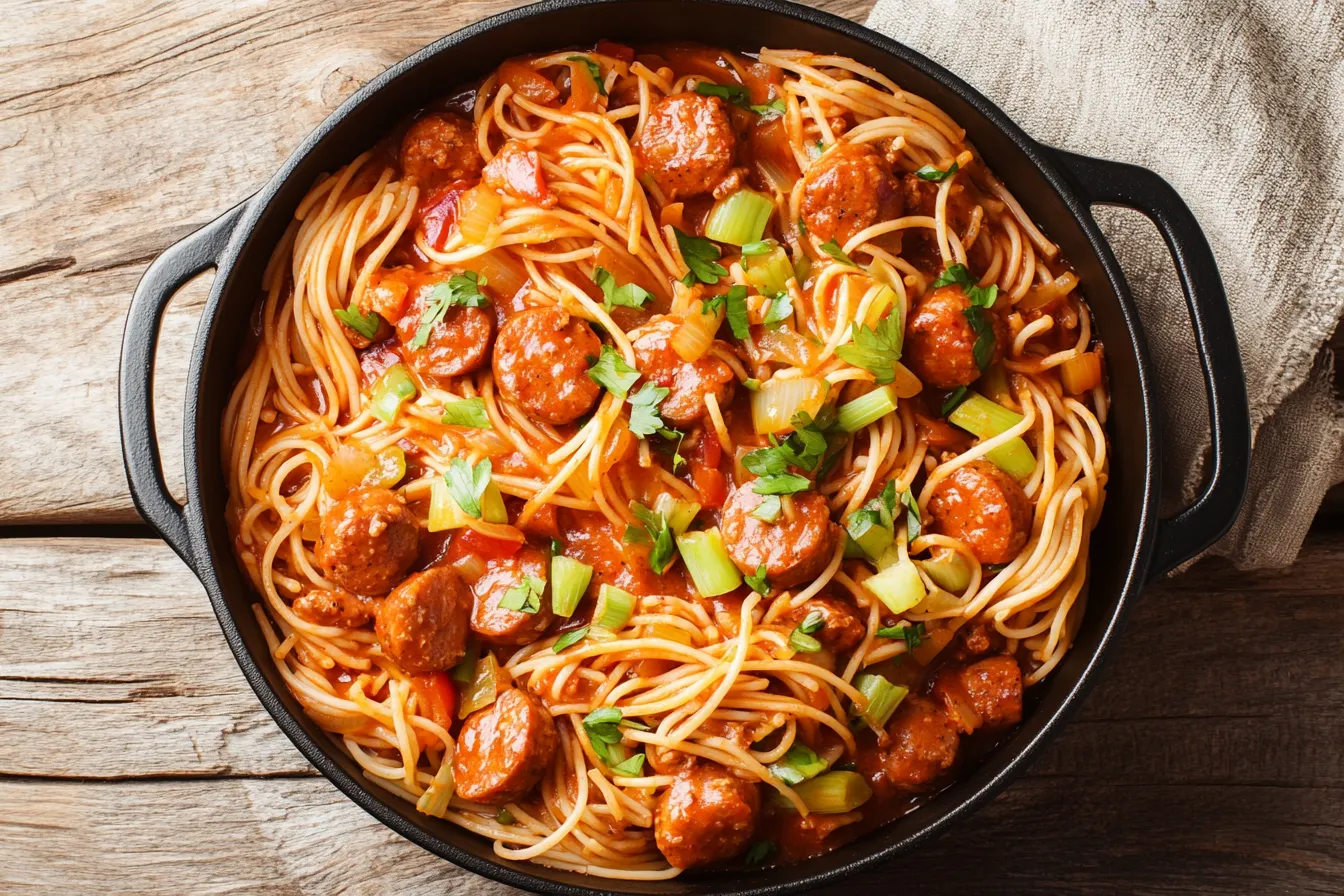Introduction
Looking for a bold, satisfying, one-pot meal that brings together rich Cajun flavor with hearty pasta? This pastalaya recipe is your new go-to dish! A modern twist on Louisiana’s famous jambalaya, pastalaya replaces the rice with pasta—resulting in a saucy, deeply flavored comfort meal that’s perfect for weeknight dinners, potlucks, and family feasts.
Pastalaya takes all the mouthwatering elements of traditional jambalaya—savory smoked sausage, tender chicken, bold Cajun spices, and the “Holy Trinity” of vegetables—and simmers it all together with dry pasta that soaks up every drop of seasoned broth. The result? A dish bursting with flavor, easy to make, and guaranteed to impress.
Whether you grew up in the South or just love a good spice-kissed pasta dish, this pastalaya hits the spot. It’s no wonder the recipe has been trending on food blogs and social media lately. People love it for its simplicity, adaptability, and its rich, slow-cooked taste made possible in just one pot.
In this ultimate guide, you’ll learn everything you need to master the art of cooking perfect pastalaya. From its Louisiana roots to step-by-step cooking instructions, expert tips, delicious variations, and storage know-how, we’ve got you covered. Plus, we’ll answer the most common questions people ask about pastalaya—so you feel confident making it for the first time or adding it to your regular rotation.
Let’s kick things off with a quick look at where this dish came from and why it’s a rising star in kitchens across the country..Tini Mac N Cheese
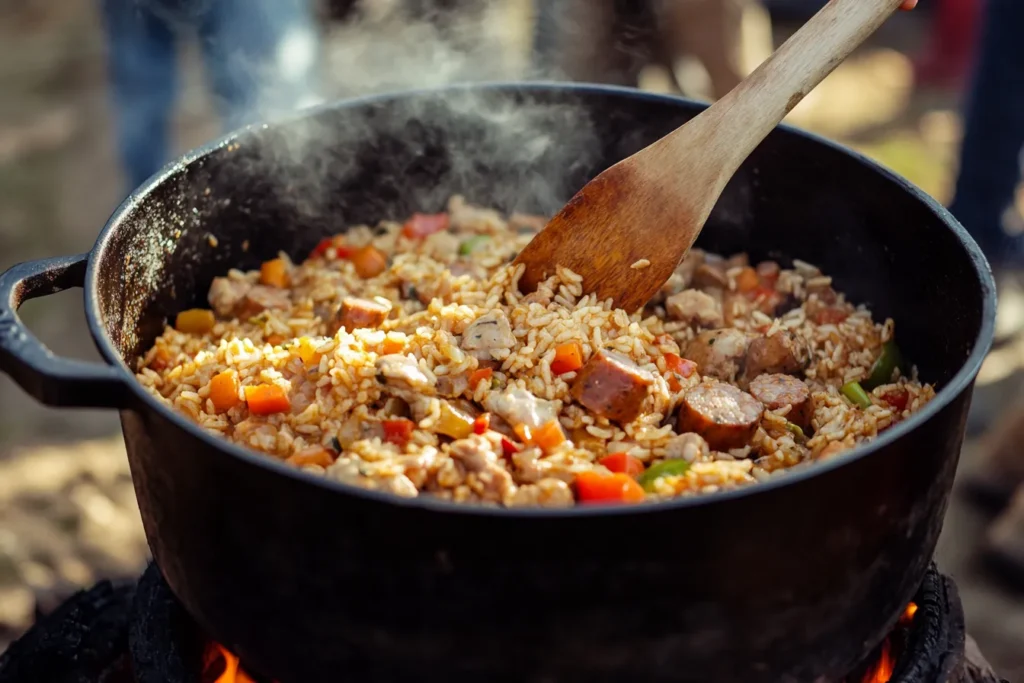
History of Pastalaya
The Louisiana Roots of Pastalaya
To truly appreciate this flavorful dish, we have to go back to its roots in South Louisiana, a region famous for its vibrant culture and unforgettable cuisine. Pastalaya is a variation of jambalaya, a traditional Creole and Cajun rice dish that emerged in the 18th and 19th centuries from the cultural melting pot of New Orleans. Jambalaya typically combines rice with meats like chicken, sausage, or seafood and is heavily seasoned with bold spices and herbs.
While jambalaya continues to be a staple at Louisiana gatherings, pastalaya is the creative pasta-loving cousin that brings something different to the table. It first gained popularity at outdoor festivals, tailgates, and large community events, where it was easier to cook large quantities of pasta than perfectly fluffy rice. Unlike rice, pasta can cook more consistently in big batches, making it ideal for party-style cooking.
From Jambalaya to Pastalaya—Why the Switch?
So, why replace rice with pasta? One word: texture. Pasta provides a soft, chewy bite that absorbs the dish’s savory broth and spices, creating a fusion of Italian-American comfort with Cajun intensity. The shift also reflects a more modern, accessible approach—dry pasta is easier to store, cooks faster, and opens up endless possibilities for variations..How to Spice Up Kraft Mac n Cheese
Over time, pastalaya became more than just a convenient alternative—it became a beloved Southern comfort food in its own right. Whether cooked on the stovetop or outdoors in massive cast iron pots, pastalaya embodies the spirit of Cajun cooking: resourceful, bold, and meant to be shared.
Ingredients Overview
The Protein Trio – Sausage, Chicken, and Shrimp
At the heart of a great pastalaya is a combination of hearty proteins, typically featuring:
- Smoked sausage (preferably Andouille for that authentic smoky flavor)
- Chicken thighs or breasts (juicier than pork and more readily available)
- Shrimp (optional, added at the end for a seafood twist)
The sausage delivers smoky spice, the chicken adds depth, and shrimp—when included—adds a sweet brininess that cuts through the richness of the dish.
The Cajun Holy Trinity – Onion, Bell Pepper, Celery
This base—known in Louisiana as the Holy Trinity—is the aromatic foundation of almost all Cajun and Creole dishes. Together, they create a flavorful backdrop that infuses every bite with warmth and depth:
- 1 onion (yellow or white)
- 1 green bell pepper (you can add red for a hint of sweetness)
- 2-3 celery stalks, diced
Add in garlic for even more aroma and complexity—usually 3–4 cloves minced finely.
Choosing the Right Pasta
Traditionally, pastalaya uses thin spaghetti, but you can easily substitute with:
- Fettuccine or linguine (for a silky, ribbon-like feel)
- Penne or bowtie pasta (great for holding onto sauce and chunks of meat)
- Rotini or rigatoni (if you want more surface texture)
Whatever shape you choose, make sure it’s uncooked when added to the pot so it absorbs all the delicious broth.
Seasonings That Bring It to Life
No Cajun dish is complete without bold spices. For a flavorful pastalaya base, you’ll want:
- Cajun or Creole seasoning – Homemade or store-bought blends are fine
- Paprika – Adds a smoky, warm undertone
- Oregano, thyme, black pepper – Build earthy balance
- Red pepper flakes or cayenne – Optional, but great for heat lovers
- Salt – To taste, but remember broth and sausage can add saltiness too
These seasonings should be added after the vegetables are sautéed and just before you deglaze the pot. This allows them to bloom in the residual oil and deliver maximum flavor.
The Liquid Base – Broth and Optional Cream
To cook the pasta and carry all those spices through the dish, you’ll need:
- 4–5 cups of chicken stock or broth – Low-sodium preferred for control over salt levels
Some variations also include:
- Heavy cream or half-and-half – For a rich, creamy version
- Diced tomatoes or tomato paste – For a red-sauce base (especially in Creole-style versions)
These ingredients not only give body and texture to the dish, but they also help the pasta cook evenly while absorbing the spices. The broth is usually added after browning the meat and vegetables and before the pasta goes in..Kraft Mac n Cheese Recipes
Optional Toppings and Garnishes
To finish off your pastalaya and give it that restaurant-quality touch:
- Chopped green onions
- Fresh parsley
- Grated Parmesan cheese (for a fusion-style finish)
These add color, freshness, and brightness to contrast with the richness of the dish.
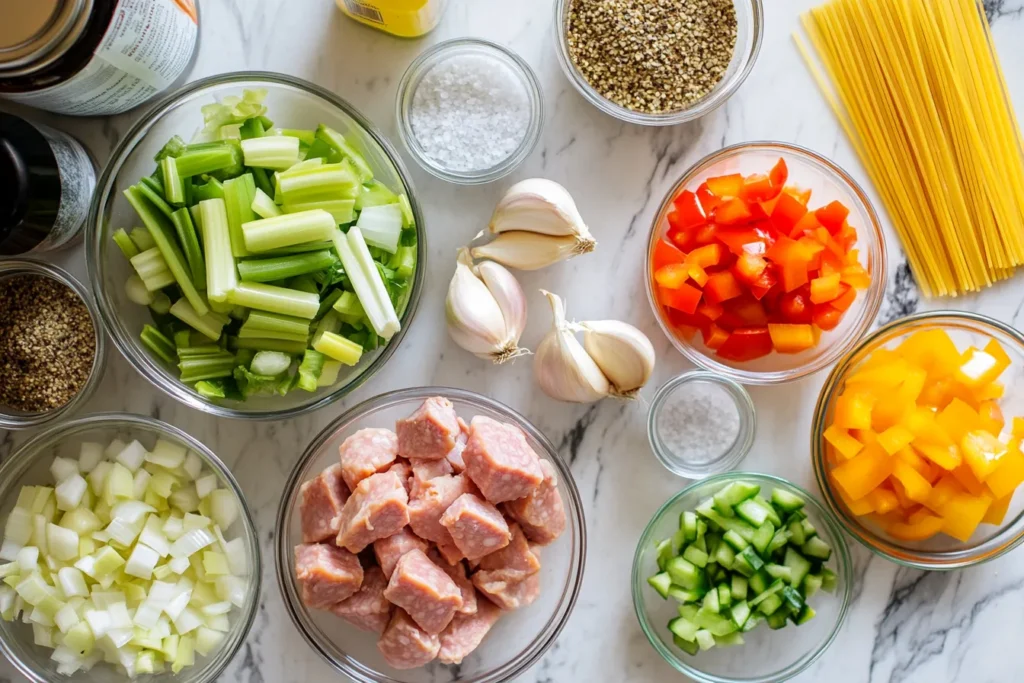
Step-by-Step Cooking Process
Step 1 – Sear the Meats to Build Flavor
Start with a large Dutch oven or deep heavy-bottomed pot over medium-high heat. Add about 1 tablespoon of neutral oil, such as canola or vegetable oil.
- First, brown your sliced sausage (usually about ½ lb Andouille or smoked sausage) until the edges are crisp and golden. This releases its natural oils and spicy flavors into the pan. Remove and set aside.
- Next, add chicken pieces (preferably boneless thighs or breasts, about ¾ lb, seasoned with Cajun spice). Sear until golden-brown and cooked through, about 4–5 minutes per side. Set aside with the sausage.
These browned bits on the bottom—called fond—are essential for a deep, umami-rich flavor base.
Step 2 – Sauté the Cajun Trinity and Garlic
With your pot still hot and flavorful, add:
- 1 diced onion
- 1 bell pepper
- 2–3 celery stalks, finely chopped
Stir occasionally and cook for about 10–12 minutes, or until softened and starting to caramelize. Add 3–4 minced garlic cloves and sauté for 1 minute more, just until fragrant.
Pro Tip: Stir constantly after adding garlic to prevent burning—it can turn bitter quickly.
Step 3 – Add Seasonings and Deglaze the Pot
Sprinkle in your seasoning blend:
- 1–2 tablespoons Cajun or Creole seasoning
- ½ tsp paprika
- ¼ tsp dried thyme
- ¼ tsp oregano
- Salt and black pepper to taste
Let these spices toast for a minute with the veggies to release their oils. Then pour in about ½ cup of chicken broth to deglaze the pot, using a wooden spoon to scrape up all that flavorful fond from the bottom.
Step 4 – Add Broth and Simmer
Return your cooked sausage and chicken to the pot. Stir in:
- 4–5 cups of chicken broth
- Optional: ½ cup diced tomatoes or ¼ cup heavy cream for a red or creamy version
Bring the mixture to a gentle boil, then reduce to a simmer. Simmer for about 10 minutes, uncovered. This helps all the flavors marry before adding pasta.
Step 5 – Add Pasta and Cook Until Tender
Add 1 lb of uncooked pasta (like spaghetti broken in half or penne) directly to the simmering liquid. Stir to make sure the pasta is evenly distributed and fully submerged.
- Cover the pot and cook on low heat for 10 minutes.
- Then, uncover and give it a gentle stir, scraping the bottom.
- Cook uncovered for another 10–12 minutes, or until the pasta is al dente and most of the liquid has been absorbed.
If using shrimp, add it in the last 5 minutes of cooking, so it doesn’t overcook.
Step 6 – Adjust and Garnish
Once your pasta is cooked:
- Add more broth if it’s too thick.
- Stir in cream if you like a creamy texture.
- Taste and adjust seasoning.
Top with:
- Chopped green onions
- Fresh parsley
- Optional: Grated Parmesan cheese (for a flavor fusion)
Serve immediately for best texture.
Secrets to the Best Pastalaya
Let the Fond Do the Heavy Lifting
The fond—the golden brown bits left after browning meat—is key to that signature deep Cajun flavor. Always deglaze it with a splash of broth before proceeding. It’s packed with savory richness.
Use Uncooked Pasta for Maximum Flavor
Dry pasta cooks directly in the seasoned broth, absorbing all those complex flavors. It also releases starch, which gives the sauce a natural silkiness. Avoid pre-cooked or parboiled pasta—it won’t work the same.
Layer Flavors, Don’t Rush
Each stage of this dish builds a layer of flavor: browning meat, softening veggies, toasting spices, simmering broth, and cooking pasta. Don’t rush through them. This is what turns simple ingredients into something magical.
Finish Uncovered for Ideal Texture
Pastalaya should be saucy—not soupy or dry. If it’s too watery near the end, just remove the lid and let it simmer uncovered. If it’s too thick, stir in a splash of broth or cream to loosen it up.
Spice It Your Way
Control the heat level by adjusting:
- The Cajun seasoning (some store-bought blends are very spicy)
- Adding or omitting cayenne or red pepper flakes
- Using milder sausage if cooking for kids or spice-sensitive guests
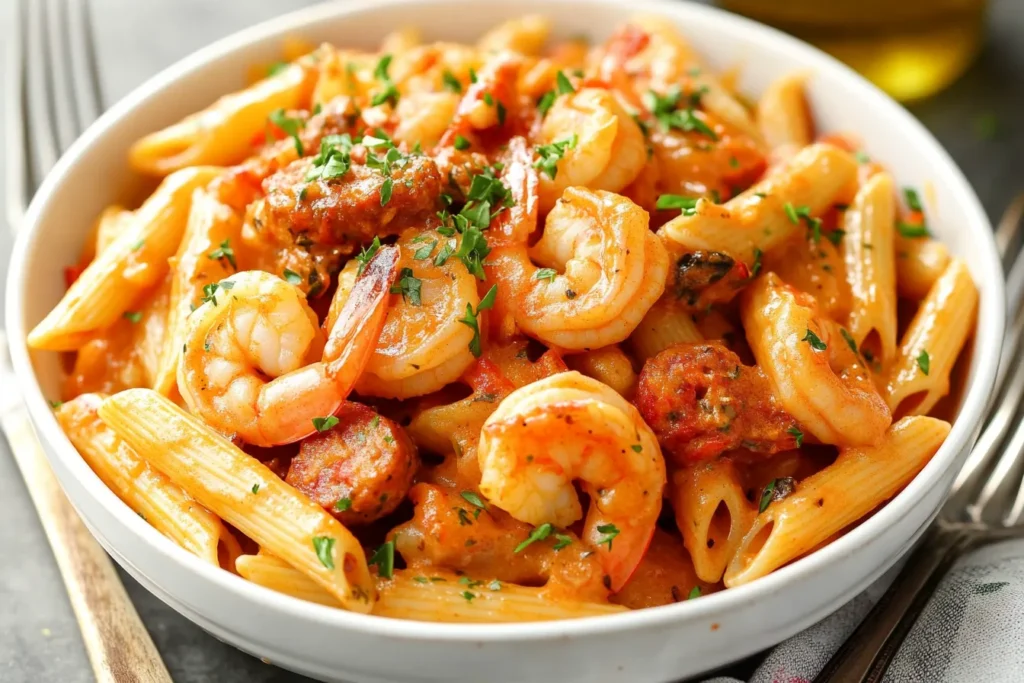
Flavor Variations of Pastalaya
Creamy Pastalaya
Want to turn your Cajun comfort dish into something even more decadent? Try a creamy pastalaya variation. After the pasta has cooked, stir in ½ to ¾ cup of heavy cream or half-and-half to create a rich, velvety sauce.
To go even further, you can:
- Add shredded Parmesan or cheddar cheese
- Finish with a pat of butter for silky smooth texture
- Include cream cheese for extra tang
This style is especially popular at restaurants or when serving kids who may prefer a milder, creamier flavor.
Tomato-Based Creole Pastalaya
Creole cooking is known for its use of tomatoes, and this variation gives pastalaya a red-sauce base similar to Italian pasta dishes. Use:
- 1/2 cup tomato paste
- Or 1 cup canned diced tomatoes, added with the broth
Tomato-based pastalaya is more tangy and slightly sweet, balancing out the savory sausage and spices.
Shrimp or Seafood Pastalaya
For a seafood twist, skip the chicken and go all-in with shrimp or crawfish tails:
- Add peeled shrimp (½ lb) in the last 5 minutes of cooking
- For crawfish, add precooked tails at the very end to warm through
This gives the dish a distinctly coastal flavor and makes it perfect for Mardi Gras or seafood boils.
Vegetarian or Vegan Pastalaya
Yes, pastalaya can be plant-based! Omit the meats and use:
- Plant-based sausage (like Beyond Sausage or Field Roast)
- A medley of mushrooms, zucchini, or eggplant
- Vegetable broth instead of chicken stock
Add in some liquid smoke and a touch of smoked paprika to mimic that signature Cajun depth of flavor.
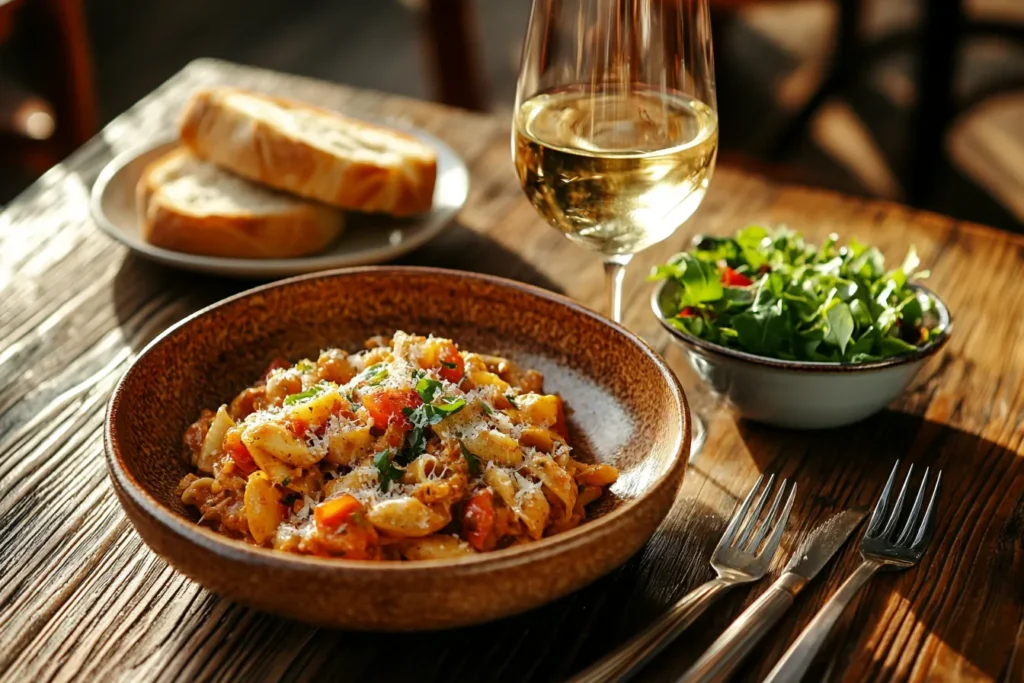
Serving Suggestions
The Perfect Side Dishes
While pastalaya is hearty enough to be a meal on its own, these sides elevate your dinner table:
- Garlic bread or French rolls – Perfect for soaking up the sauce
- Simple green salad with vinaigrette – For freshness and crunch
- Cornbread – A Southern staple to balance the spice
- Coleslaw – Adds creaminess and contrast
Drinks That Pair Well
Pair pastalaya with drinks that balance the spice:
- Sweet tea or lemonade
- Light beer (like lager or pilsner)
- Dry white wine – Sauvignon Blanc or Pinot Grigio
- For an adult Cajun touch: Hurricane cocktail or bourbon neat
Occasions to Serve Pastalaya
This dish is a hit for:
- Weeknight dinners
- Potlucks
- Tailgate parties
- Family gatherings
- Mardi Gras celebrations
It scales easily and can be made ahead, making it ideal for big events.
Common Mistakes to Avoid
Overcooking the Pasta
Since the pasta cooks directly in the broth, it’s important to:
- Stir occasionally so it doesn’t stick
- Cook just until al dente
- Remove from heat immediately when done
Mushy pasta can ruin the dish’s texture.
Not Browning the Meat
The browned bits (fond) from sausage and chicken are essential for developing flavor. Skipping this step results in a flat, bland dish. Always sear your meats before anything else.
Adding Too Much Liquid
Too much broth leads to a soupy consistency. Start with about 4 cups, then add more only if needed during pasta cooking. It’s easier to add than remove.
Skimping on Seasoning
This is a Cajun dish—don’t be afraid of flavor! Use bold amounts of Creole seasoning, taste frequently, and adjust as needed. Remember that pasta will mellow out the spice, so season a bit stronger than you think.
Using Pre-Cooked Pasta
Dry pasta is essential because it soaks up the broth and seasoning. Pre-cooked pasta will become mushy and won’t absorb flavor.
Pastalaya for a Crowd
Scaling Up the Recipe
Pastalaya is often cooked in giant cast iron pots at fundraisers, festivals, or crawfish boils. To scale for 20–30 people:
- Use 3–4 lbs of pasta
- 3–4 lbs of meat total
- 12–14 cups of broth
Maintain the same ratios, and cook over a steady heat with frequent stirring.
Use a Propane Burner or Outdoor Cooker
If cooking for a large crowd:
- A 36-quart stockpot or Cajun cooker is ideal
- Use a propane burner for even heat
- Stir constantly to prevent pasta from sticking and scorching
Crockpot or Slow Cooker Method
You can also prep pastalaya in a slow cooker:
- Brown meat and sauté vegetables separately
- Add all ingredients to crockpot except pasta
- Cook on low for 4–6 hours
- Add uncooked pasta in the last 30–45 minutes
This works well for potlucks, office parties, or set-it-and-forget-it dinners.
Frequently Asked Questions
What is the difference between jambalaya and pastalaya?
The key difference is in the carbohydrate base. Traditional jambalaya uses rice, while pastalaya replaces rice with pasta—often spaghetti, penne, or fettuccine. The flavor profile, spices, proteins, and vegetables are otherwise very similar. Pastalaya tends to be a bit richer due to the pasta’s starchiness and ability to absorb sauce, while jambalaya has a firmer bite from the rice.
Can I make pastalaya ahead of time?
Absolutely! In fact, pastalaya tastes even better the next day because the flavors have more time to meld. To make ahead:
- Cook the dish completely
- Let it cool, then store in airtight containers in the refrigerator
- Reheat on the stove or microwave, adding a splash of broth or cream to restore moisture
Avoid overcooking the pasta initially if you plan to reheat, as it can get mushy with extended storage.
What’s the best pasta for pastalaya?
Thin spaghetti is the most common choice in traditional Cajun pastalaya, but you can also use:
- Fettuccine – for a silkier, richer texture
- Penne or bowties – easier to serve in large batches
- Rotini – holds sauce and seasoning well
Avoid delicate or quick-cooking pastas like angel hair, which can break down too quickly.
How spicy is pastalaya supposed to be?
That depends on the Cajun seasoning blend you use. Some are salt-forward and mild, while others pack a serious heat. Most recipes aim for a medium heat level, but you can adjust it:
- Use a milder sausage if you’re cooking for kids
- Omit cayenne or red pepper flakes for a gentle version
- Add hot sauce or extra cayenne for a fiery kick
Balance is key—pastalaya should be bold, not overwhelming.
Can I freeze pastalaya?
Yes, pastalaya freezes well for up to 3 months. Just follow these steps:
- Let it cool completely
- Transfer to freezer-safe containers or zip-top bags
- Label and date it
- To reheat, thaw in the refrigerator overnight and warm on the stovetop with a splash of broth
Note: Creamy versions may separate slightly when frozen, but the texture can be restored by stirring in fresh cream or cheese during reheating.
How do I make pastalaya less greasy?
A few simple tricks help reduce greasiness:
- Drain excess fat after browning sausage and chicken
- Use leaner cuts of meat, such as chicken breast or turkey sausage
- Opt for low-sodium, fat-free broth
- Skim fat from the top before serving if needed
If your pastalaya ends up too oily, you can blot the surface gently with a paper towel before stirring in final garnishes.
Bonus Questions
Q: Can I use gluten-free pasta?
Yes! Just adjust your cook time accordingly and choose a sturdier gluten-free brand like brown rice or chickpea pasta. Avoid over-stirring, as some gluten-free pastas are delicate and may break apart.
Q: Is pastalaya a good meal prep dish?
Absolutely. It stores well, freezes beautifully, and the flavors improve over time. Divide it into meal containers and enjoy it for lunch or dinner throughout the week.
Q: How do I thicken or loosen pastalaya?
To thicken: simmer uncovered at the end. To loosen: stir in warm broth or cream until you reach the desired consistency.
Conclusion
If you’re looking for a bold, comforting, one-pot meal that captures the heart of Cajun cooking, this pastalaya recipe is exactly what you need. By swapping out rice for pasta, this dish takes traditional jambalaya and gives it a modern, satisfying twist that’s rich in flavor and easy to prepare.
From the smoky sausage and juicy chicken to the tender pasta infused with Cajun spices, every bite of pastalaya is a celebration of Louisiana flavor. Whether you’re cooking for a weeknight dinner, feeding a crowd at a tailgate, or prepping meals for the week, this dish checks all the boxes—flavor, simplicity, versatility, and soul.
Now that you’ve seen how to make it step-by-step, along with tips, variations, FAQs, and party-size versions, the only thing left to do is gather your ingredients and start cooking.
Trust us: one taste and this pastalaya recipe will be your new go-to comfort dish. Laissez les bons temps rouler—let the good times roll!
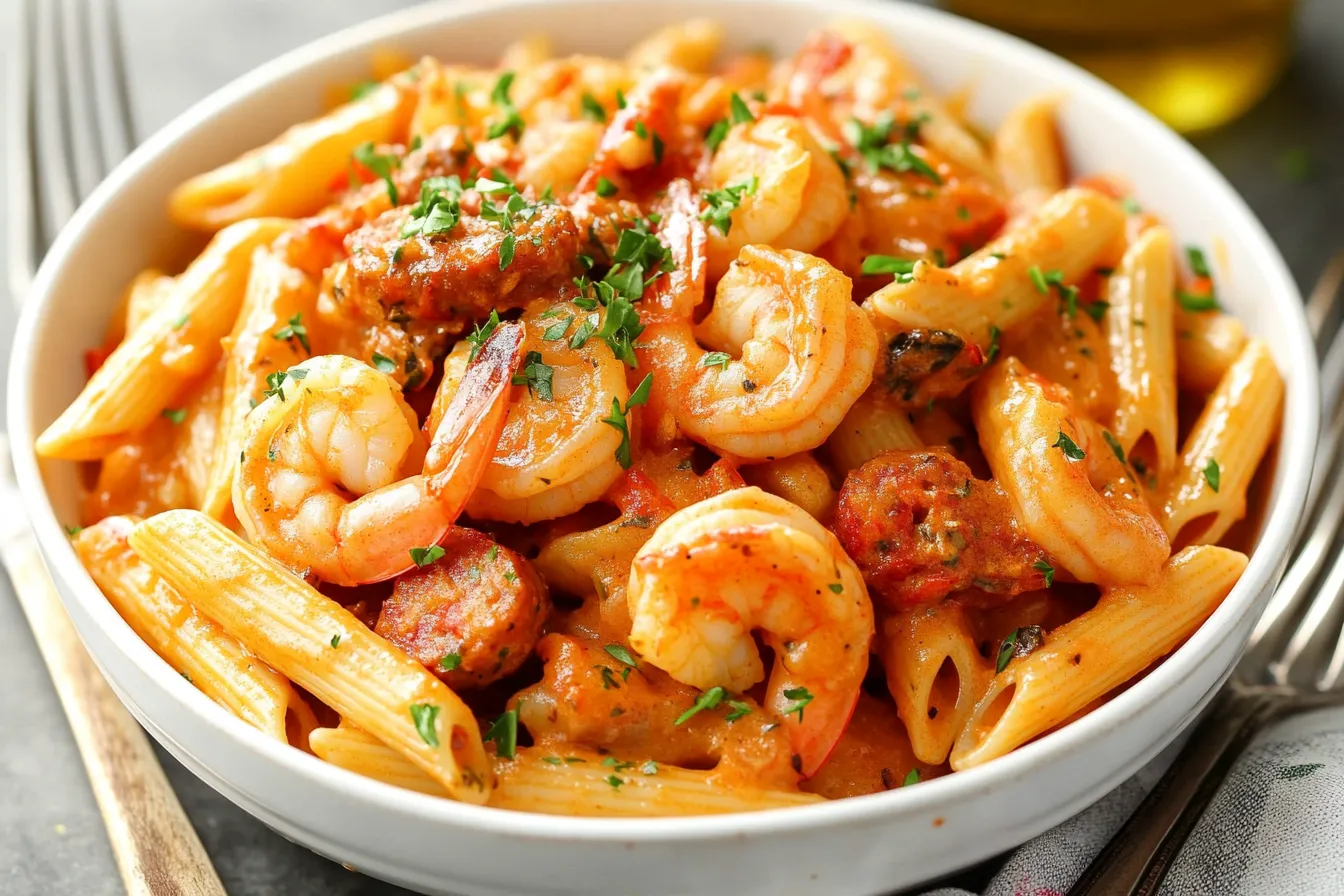
Name: Pastalaya Recipe – One-Pot Cajun Pasta
Ingredients
Equipment
Method
- Instructions:
- Heat oil in a large Dutch oven over medium-high heat. Add sliced sausage and brown until golden. Remove and set aside.
- Add cubed chicken and sear on all sides until browned. Remove and set aside with the sausage.
- In the same pot, add onion, bell pepper, and celery. Cook 10–12 minutes until soft and beginning to caramelize. Stir in garlic and cook 1 more minute.
- Add Cajun seasoning, paprika, thyme, oregano, salt, and pepper. Stir to coat vegetables, then deglaze the pot with ½ cup of broth, scraping up browned bits.
- Return sausage and chicken to the pot. Pour in remaining broth. Bring to a boil, then reduce heat and simmer uncovered for 10 minutes.
- Stir in uncooked pasta. Cover and cook on low for 10 minutes. Uncover, stir, and cook another 10–12 minutes until pasta is al dente and most liquid absorbed.
- If using shrimp, stir them in for the final 5 minutes of cooking.
- For a creamy version, add heavy cream during the last 3 minutes and stir until heated through.
- Taste and adjust seasoning. Garnish with green onions and parsley before serving.
Notes
Add a splash of extra broth before serving if it seems too thick. Avoid pre-cooked pasta—it won’t absorb flavor properly. Can be made a day ahead. Flavor improves over time. Easily customizable with tomato base, cream, or seafood-only options.

